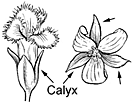Lama
Diospyros hillebrandii
Persimmons family (Ebenaceae)
Native species ()
This species of lama is confined to Oahu and Kauai. It has large dark green leaves which have a network of fine veins on the upper surface and also the are short-pointed. The pink flushes of new foliage on red twigs over a tree are showy.

Keoki Stender
Leaves in two rows, hairless, with short leaf-stalks less than 1⁄4 inch (6 ) long. Blades oblong, 3–6 inches (7.5–15 ) long and 1 1⁄4–2 1⁄2 inches (3–6 ) wide, blunt at rounded at base, not on edges, slightly thickened, the upper surface shiny dark green with a prominent network of fine veins when dry, the lower surface dull light green.
Flowers male and female on different plants (), single and stalkless at leaf bases, 3⁄8 inch (10 ) long with overlapping at base. Male flowers have green narrow tubular of 1⁄4 inch (6 ) with three short-pointed hairy at end, tubular bell-shaped pink hairy with three spreading and nine short Female flowers have and with a hairy and three-forked
(berries) elliptical, 3⁄4–1 inch (20–25 ) long, slightly curved on 1 side and widest beyond middle, hairy toward blunt with point from orange, and at base the enlarged 1⁄4 inch (6 ) long with 3 short-pointed nearly dry, edible but insipid. Seeds are elliptical, 5⁄8 inch (15 ) long, shiny brown black.
Sapwood is whitish yellow (heartwood color unknown), hard, similar in appearance and use to D. ferrea.
Scattered in wet forests of Koolau and Waianae Ranges of Oahu to 2000 ft (610 ) altitude. In mountains near Honolulu and not uncommon on Kauai at Kokee and in Kipu Range.
Special area
Wahiawa
Range
Oahu and Kauai only
Other common name
ēlama
Botanical
Maba hillebrandii Seem.
This species honors William Hillebrand (1831-86), German-born physician and botanist, who lived in Honolulu for 20 years. His classic “Flora of the Hawaiian Islands” (1888) remains a very useful reference a century later.






